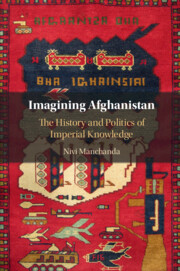Book contents
- Imagining Afghanistan
- Imagining Afghanistan
- Copyright page
- Dedication
- Epigraph
- Contents
- Figures
- Acknowledgements
- Introduction
- 1 The Construction of Afghanistan as a ‘Discursive Regime’
- 2 A Space Contested, or the ‘State’ of Afghanistan
- 3 The Emergency Episteme of the ‘Tribe’ in Afghanistan
- 4 Framed
- 5 Subversive Identities
- Coda
- References
- Index
4 - Framed
Portrayals of Afghan Women in the Popular Imaginary
Published online by Cambridge University Press: 09 June 2020
- Imagining Afghanistan
- Imagining Afghanistan
- Copyright page
- Dedication
- Epigraph
- Contents
- Figures
- Acknowledgements
- Introduction
- 1 The Construction of Afghanistan as a ‘Discursive Regime’
- 2 A Space Contested, or the ‘State’ of Afghanistan
- 3 The Emergency Episteme of the ‘Tribe’ in Afghanistan
- 4 Framed
- 5 Subversive Identities
- Coda
- References
- Index
Summary
If ‘tribal’ is the first word that comes to mind when talking about Afghanistan, the image of women in burqas forms its visual counterpart. The ‘plight of women’ is frequently invoked to inform the world of the backwardness and brutality of the government and people (especially the men) of Afghanistan. By examining an array of articles, commentaries and political testimonies, Chapter 4 underscores the problematic and politicised assumptions that guide ostensibly ‘neutral’ liberal discourses on saving Afghan women. Rather than making an ontological assertion about the (misread and misunderstood) character of Afghan women – not least because such a diverse group cannot be said to have a single character – this chapter focuses on discourse productivity as a process by which certain narratives sanction particular policies and validate some lifestyles and marginalise others.
- Type
- Chapter
- Information
- Imagining AfghanistanThe History and Politics of Imperial Knowledge, pp. 143 - 179Publisher: Cambridge University PressPrint publication year: 2020

